The Seiko Spring Drive Tuna – A Look Back
Make no bones about it; the Seiko Spring Drive Tuna is the most over the top watch I own. Strike that, mine is even zanier because it’s the limited edition Spring Drive Golden Tuna. Yes, I know that this article publishes on a Thursday, which means it’s #TBT and vintage, but I’ll bend the rules – big time I suppose – because I will review a watch that isn’t vintage but it has been out of production for roughly three years. You see, I have a soft spot for the big brand from Japan and, therefore, I’ll invoke some license to talk about a seriously different watch.
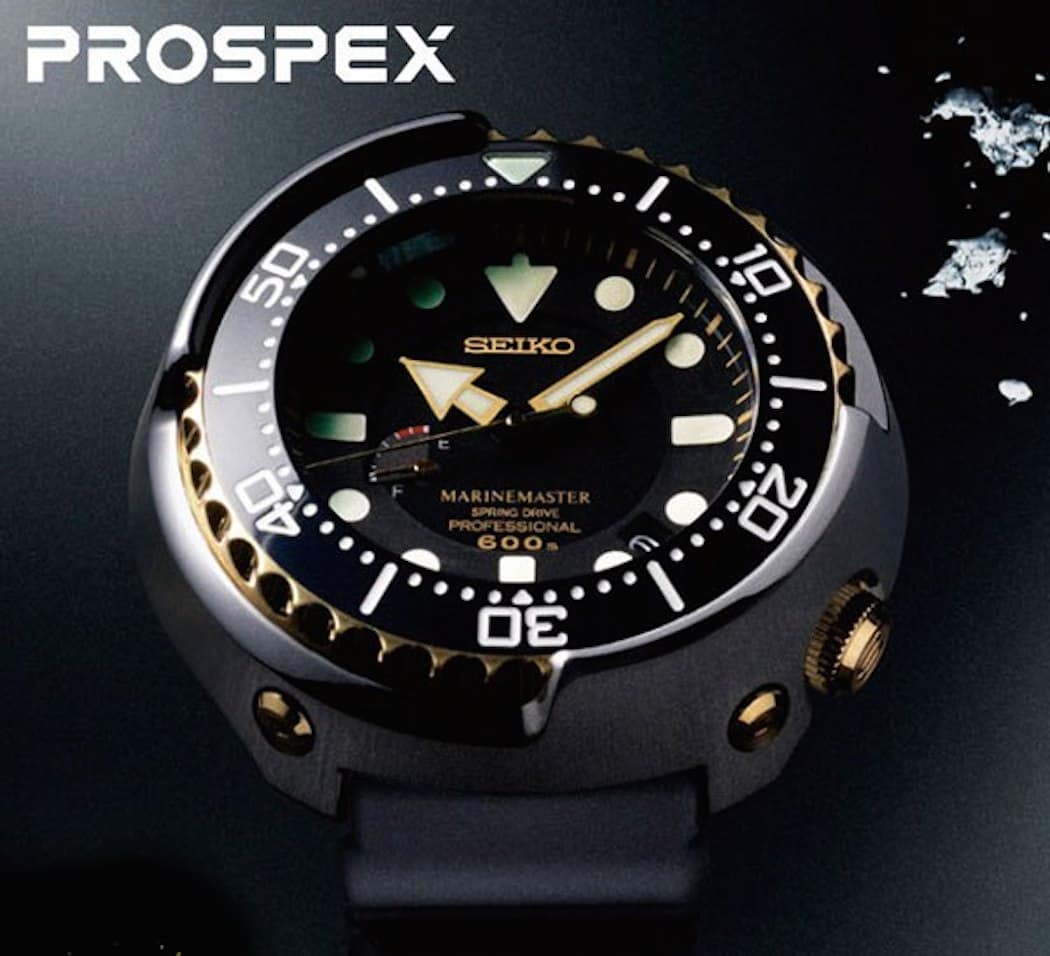
The official release photo of the Golden Seiko Spring Drive Tuna from 2013 (photo credit: Seiko)
The Birth of the Seiko Spring Drive Tuna
We’ve covered Tunas here on Fratello Watches and, in fact, a comparison I wrote about the original 6159 Tuna as compared to its now-retired distant offspring, the SBDX011, was one of my earliest articles. These automatic pieces are really the most iconic and emblematic of the case style. However, quartz Tunas came around only a few years after the original 6159 – the battery-powered pieces debuted in 1978 – and they’re not to be dismissed. Seiko even put a kinetic movement into the case in the 1980’s for a brief period and they’re now tough finds. So, in 2013, I was more than intrigued when Seiko, in celebration of 100 years of watchmaking, decided to put its coveted movement into the big case to create the Seiko Spring Drive Tuna – and then they added some gold.
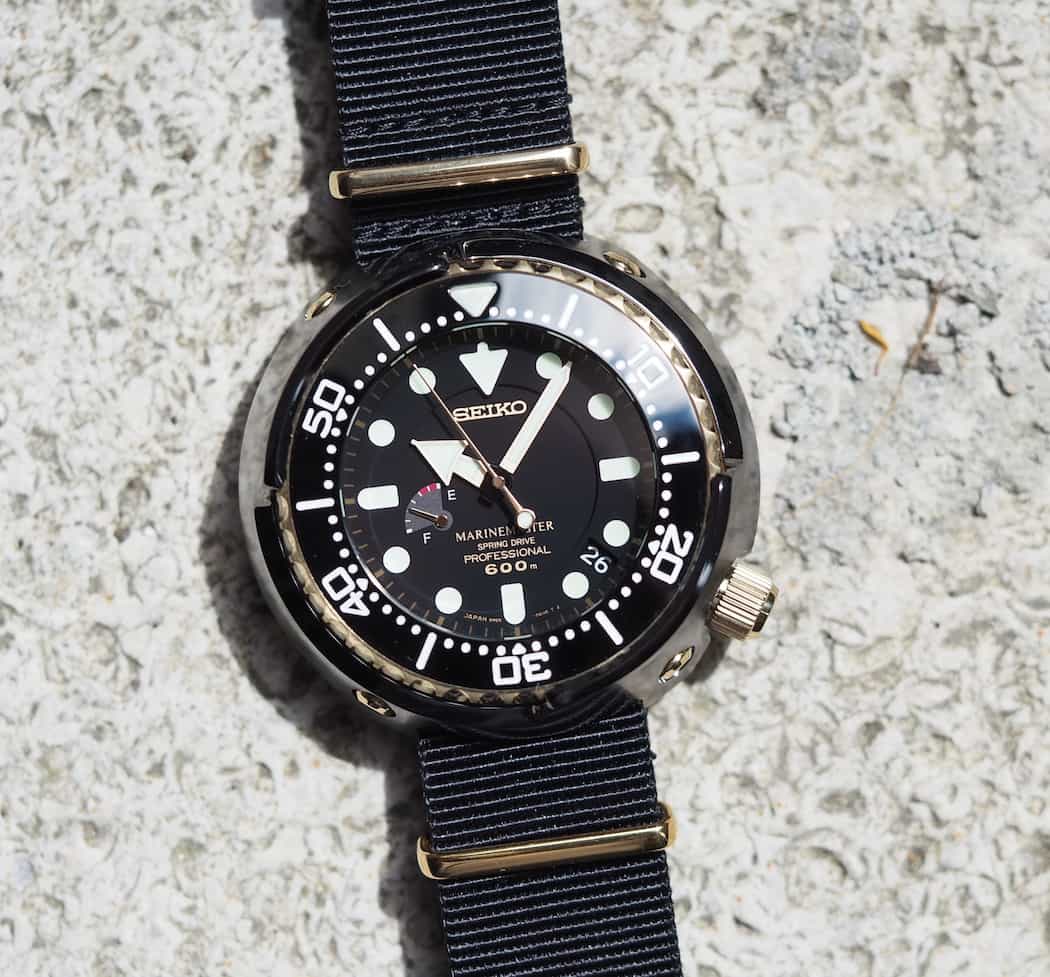
After owning the Seiko Spring Drive Tuna for several years, I’ve become a fan of the newer styled hands
And the First Edition was “Golden”
The initial Seiko Spring Drive Tuna is what you see on the page before you. The official reference is the SBDB008 and upon its announcement the reaction was what I’d call lukewarm. Here was Seiko, a company that shakes things up at what seems to be at a snail’s pace, introducing a Tuna with gold all over and with newfangled hands that were a clear departure from Tuna’s past. The fans? They weren’t so sure, but what they didn’t realize is that the use of an arrow hand for the hours and a stick for the minutes was really the introduction of a design standard for all Tunas going forward.
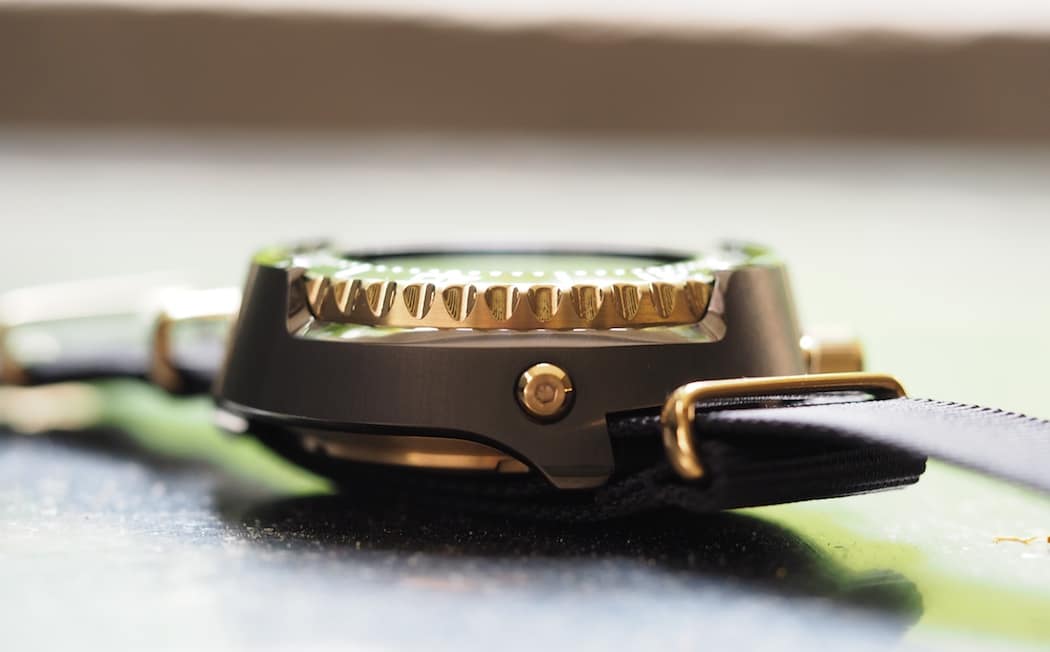
A look at the profile of the Seiko Spring Drive Tuna
Additionally, fans weren’t too sure about the color scheme of the first Seiko Spring Drive Tuna because of the addition of gold. Sure, the original quartz Tunas were gold and many other Seiko Divers, such as the famous 6215 and 6159 (non-Tuna) added gold highlights to the mix, but it was just a bit over the top for some. However, in this case, Seiko needn’t have worried about the detractors because only 300 of these pieces were being made. The price? Try somewhere just shy of $4,000 depending on currency values.
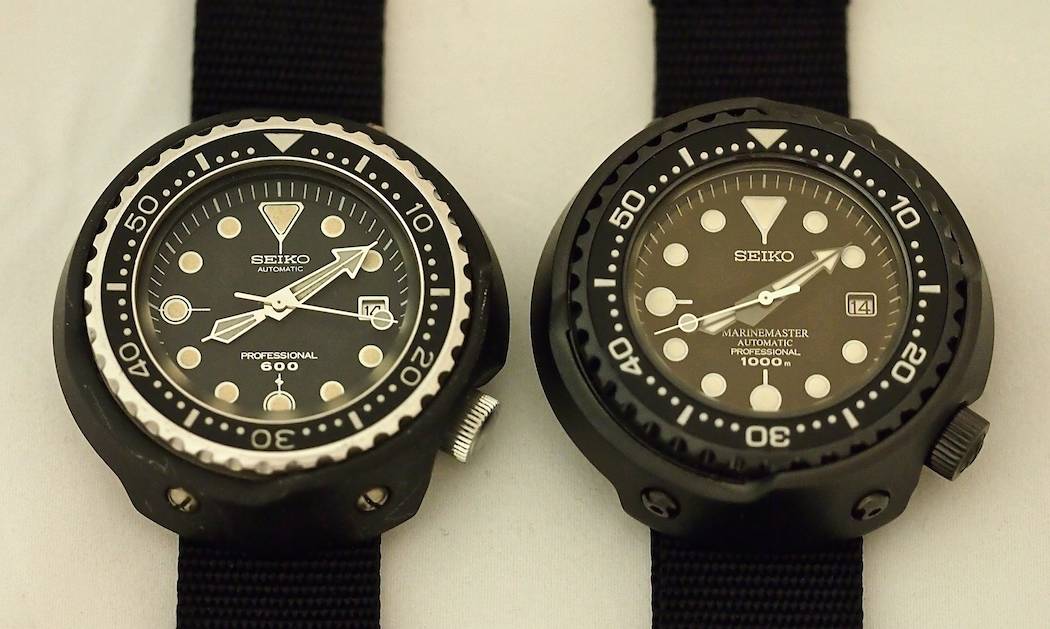
The original 6159 “Grandfather” Tuna on the left and the SBDX011 “Emperor” Tuna
With only 300 made, I wanted one…
Coming back to me, I was in full Seiko stride in 2013 and had just returned from Japan with the two Tunas mentioned above (the “Grandfather” and the “Emperor”) when I stumbled onto the announcement of the first Seiko Spring Drive Tuna. No matter the criticisms, I wanted it. Now, only a few years ago, those of us outside of Japan were dealing with a Seiko far different than the one we know today. Boutiques weren’t all over the world and the offerings outside of the homeland were, in a word, blah. In an odd experiment, though, Seiko decided to grant one of its most supportive American dealers, Arizona Fine Time, roughly 12 of these watches for sale. I knew I wasn’t headed back to Japan any time soon and even if so – if you know anything about the love of limited editions by the local population, I didn’t stand a chance. So, I shot an email to Arizona Fine Time, which led to a deposit a good 4-5 months before arrival of the watch. It was a long wait.
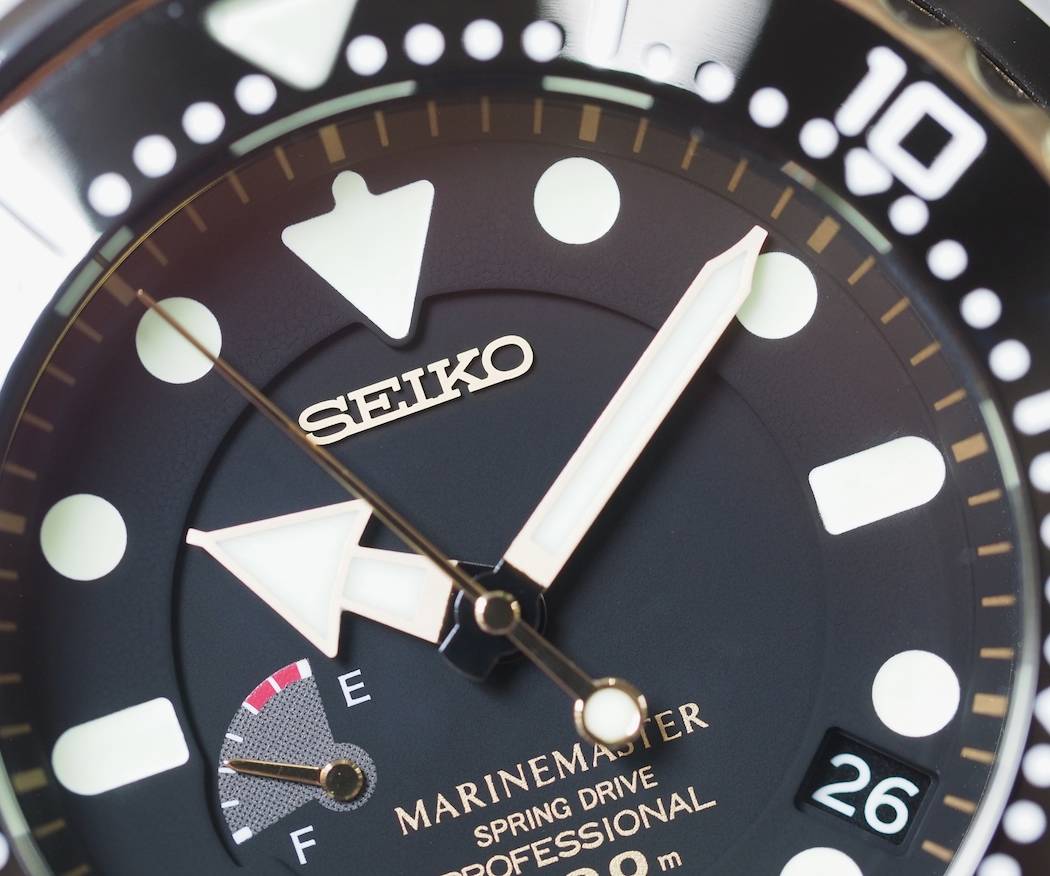
Note the lovely details on the Seiko Spring Drive Tuna such as the bezeled date window and how the 12:00 index intercepts the step
The Seiko Spring Drive Tuna arrived!
I still remember opening the box of the Seiko Spring Drive Tuna for the first time and I remember thinking two things. First, “damn, that’s a big hunk of a watch”. Second, without even handling it, I could tell that this was a Seiko like none other I’d seen in terms of finishing. When I actually removed the watch from the box and took a closer look, the finishing took on a whole other dimension; it was simply amazing. Then, I unscrewed the crown, set the date and time and wound it until the dial power reserve read full…whoa.
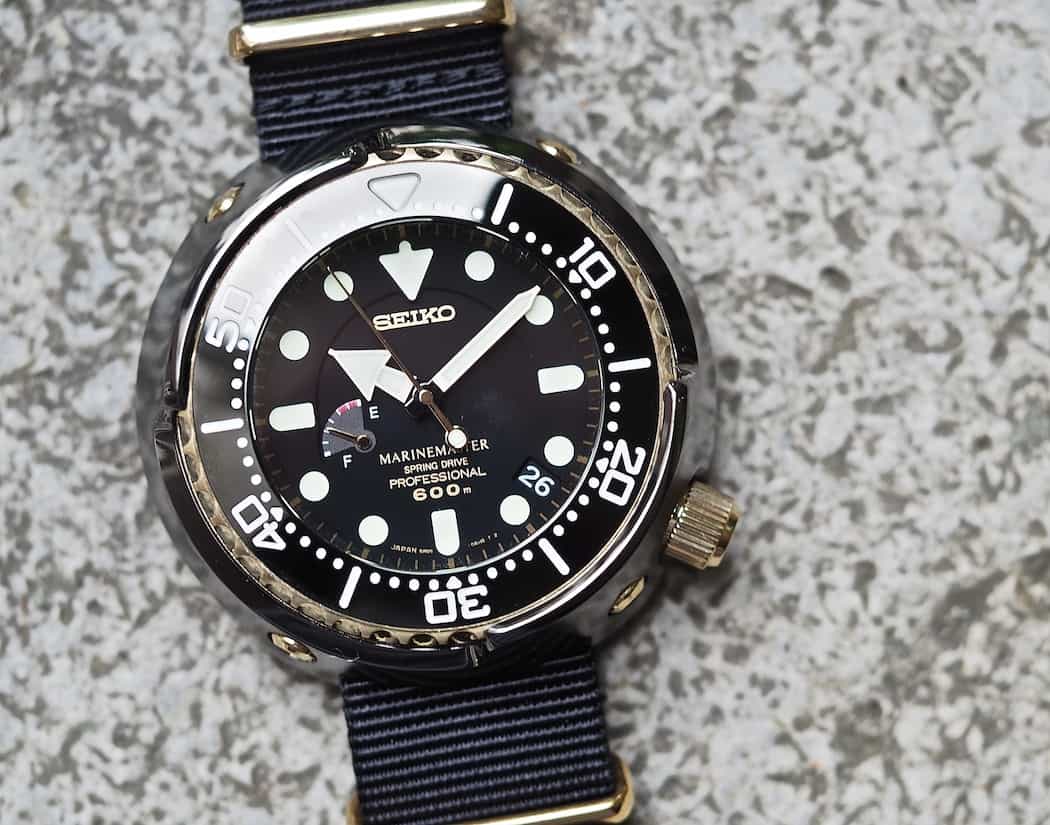
The gold bezel, with its deep ridges, looks amazing on the Seiko Spring Drive Tuna
Spring Drive…what a movement!
Holding and owning the Seiko Spring Drive Tuna marked my first experience with the lauded movement that the brand so proudly flaunts on its website and I was deeply impressed. I’ll skip the technical bits but the movement, in this case a 5R65, is a hybrid between a quartz and automatic movement. However, it’s absolutely silent and as so many have recounted, the second’s hand glides around the dial. In fact, the way the hand moves is mesmerizing and I’ve often read that owners are caught staring at their watches for lengths of time. I get it – completely. Plus, the movement contains a lengthy 72-hour power reserve, hacks, and is officially accurate to within one second per day. Owners, however, seem to enjoy measuring their Spring Drives and often find that 1-2 seconds per month variation is more typical.
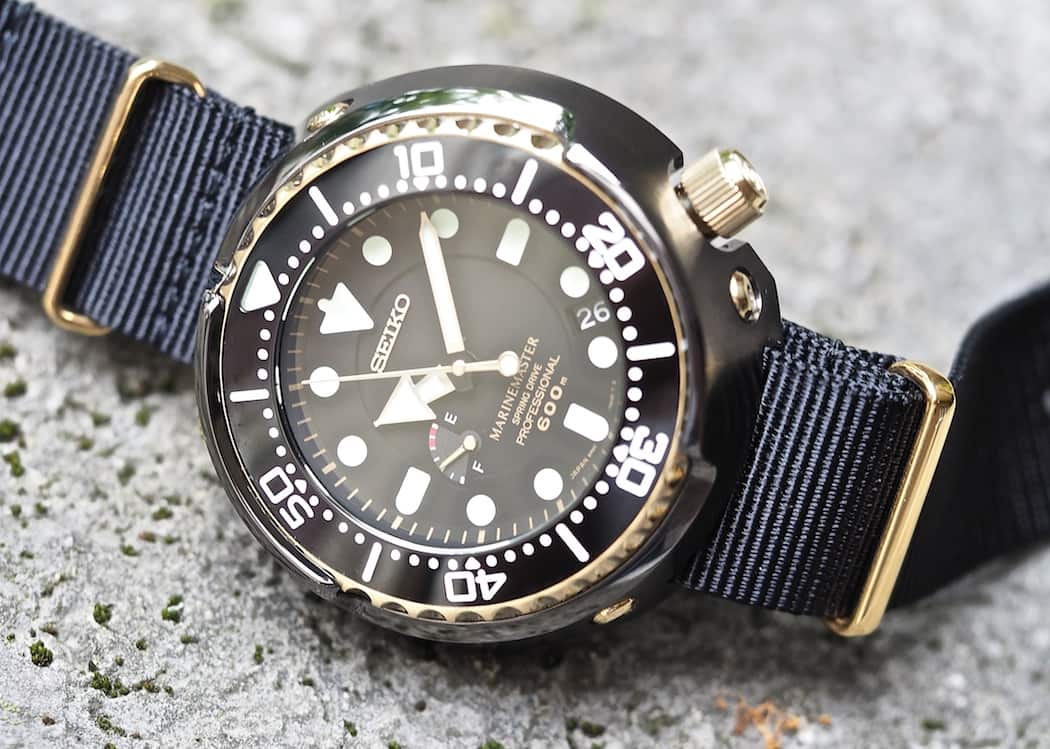
The anti-reflective coating on the sapphire crystal of the Seiko Spring Drive Tuna is extremely effective
The Seiko Spring Drive Tuna contains amazing finishing…
Coming back to the finishing and styling, let’s start with the dial. It’s viewed through a flat sapphire crystal that contains some serious anti-reflective coating – so much so that photographing it can be a real challenge in brighter conditions. Anyhow, the dial itself is a wonderful matte finished object that sits below a very deep, and steep, chapter ring with gold lines indicating the minutes. The dial, on first view, looks flat, but a closer look – or one at the right angle – shows that it actually steps down inside the minute indices. It’s a cool detail that comes off as expensive and thoughtful versus your typical flat-dialed diver. Plus, within this inner circle, one can find the lovely small date window, applied Seiko name in matte gold, the details showing the model name and 600m of water resistance, and the signature power reserve scale.
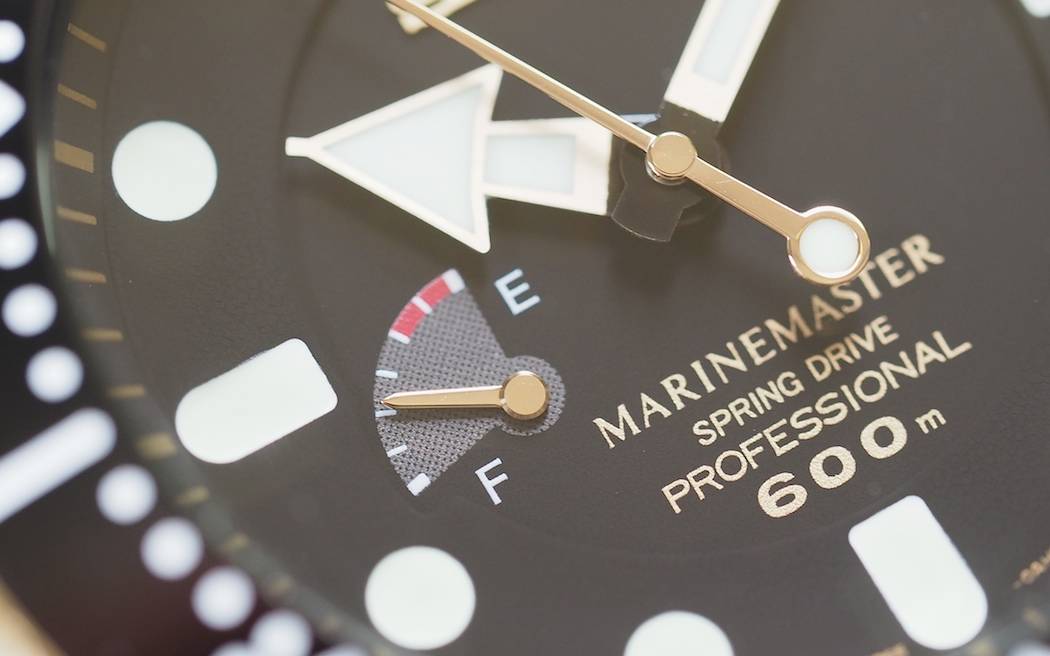
A close up of the power reserve indicator on the Seiko Spring Drive Tuna
The power reserve indicator on the Seiko Spring Drive Tuna is another source of consternation to some and I kind of get it. On the one hand, I can easily imagine this dial without this meter and it seems pretty darn pleasing. On the other hand, this is an absolute signature of almost all Spring Drive models. So, I’ve learned to live with it and it’s actually fairly non-intrusive due to its smaller size.
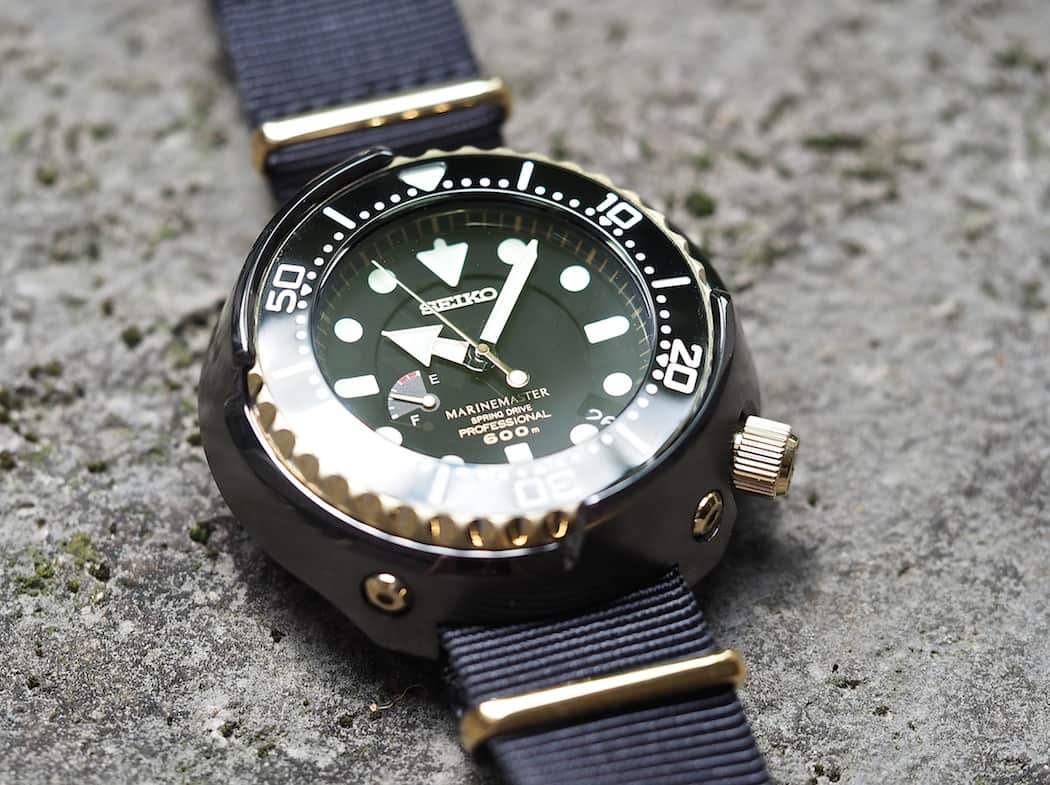
The Seiko Spring Drive Tuna with its deeply set dial
Let’s hit upon a couple other items such as the hands and hour markers because they represent large departures from the historic Tunas. With the introduction of the Seiko Spring Drive Tuna, gone were the simple dots denoting the hours and the printed inverted triangle at 12:00. In their place were bold printed circles, soft pill-shaped markers, and a simpler triangle up top. They’re big visible beacons filled with Seiko’s trademark Lumibrite and they light up like a proverbial Christmas tree at the first hint of darkness. Then, we move on to the hands. In fact, the design is basically a reversal of what used to be – the arrow has moved from the minute to the hour hand and the overall design has become less fussy and far more basic. The lume-filled areas are larger and only the hour hand is bisected by gold to form two different regions. The sweep hand also does a reversal as the lollipop moves from the long end to the short. What do I think of the hands change? Well, I actually think that the updated hands suit the dial of this watch far better than the older, more detailed units. Change happens and I think that over time, fans will come to adopt these.
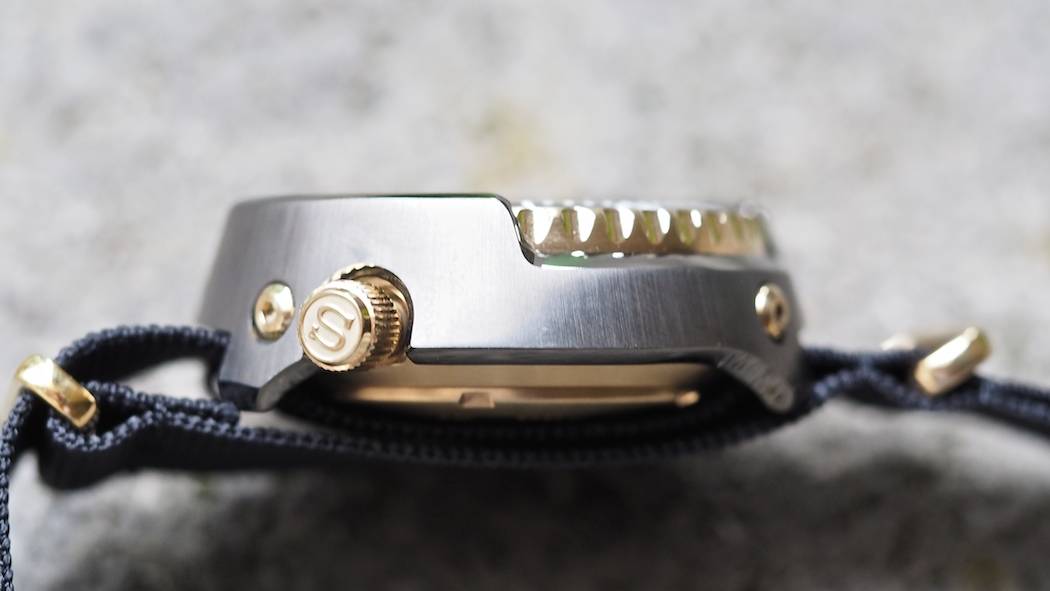
A view of the gorgeous grey DLC shroud with its vertical striations on the Seiko Spring Drive Tuna
Titanium is the word when it comes to this Tuna
On most watches, the dial is really the hallmark, but in the case of a Tuna, it’s all about the case. With the Seiko Spring Drive Tuna, this is no different. In this golden execution, and the subsequent black version I’ll discuss, the nearly 50mm diameter watchcase is crafted entirely of titanium. The shroud, as it’s called, is made of grey DLC-coated titanium, while the inner case is constructed of nitride-coated titanium. All told, it’s still a heavy piece but it does stay true to the construction of the original 6159. Detail wise, the shroud is like a work of art. It’s vertically brushed and it’s beautiful. It’s extremely tall – this watch is roughly 16.5mm tall(!!) – but the softness of the grey color works so well with the gold screws, crown and bezel edge. Oddly, it actually reminds me, color-wise, of another watch I love so much: the titanium Omega Speedmaster Professional Apollo 11 LE from 2014. Coming the case back, it naturally features the tsunami and unlike its ancestor, does allow for rear access to the movement. Also note the hidden 22mm lugs that are actually part of the shroud.
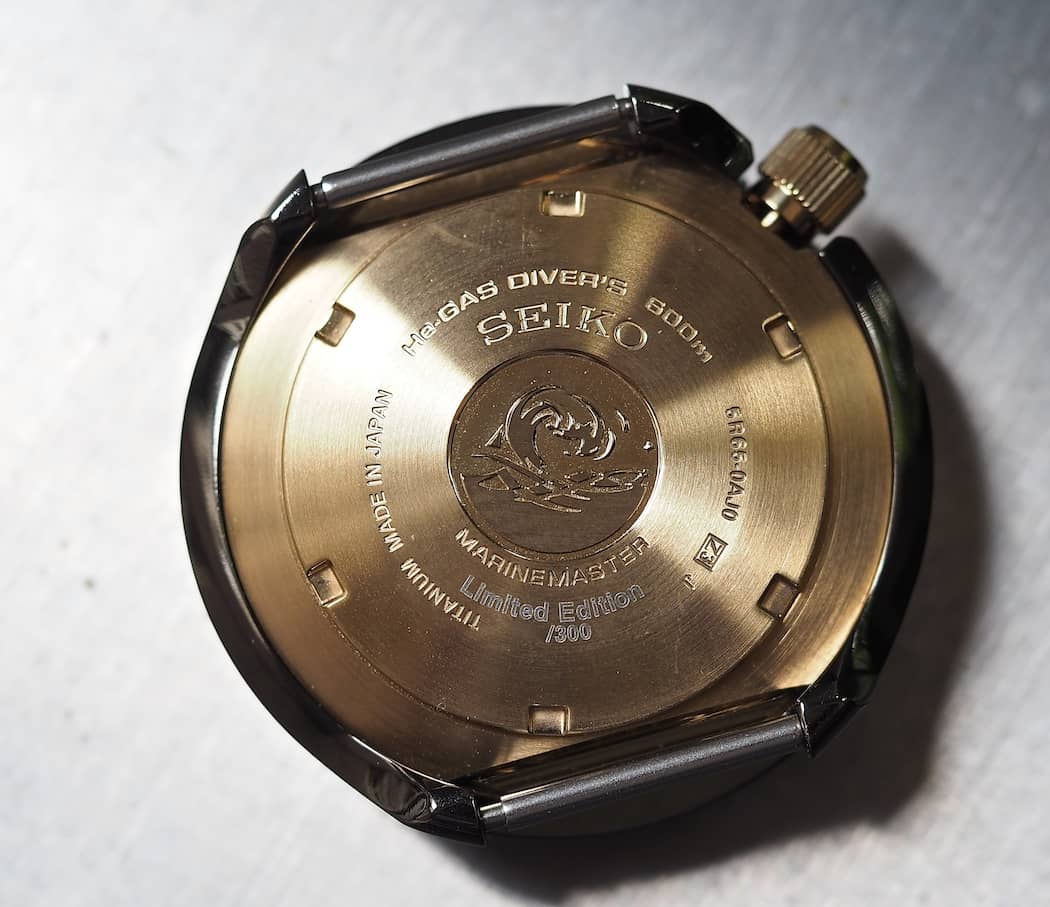
The case back of the Seiko Spring Drive Tuna
Flipping the watch back over, it’s important to spend a moment on the bezel of the Seiko Spring Drive Tuna. It’s easily accessed between the shroud gaps and it turns with such marvelous precision – it gives Rolex a true run for its money. Plus, it’s ceramic in this case with an inlaid Lumibrite pip at 12:00. All in all, it’s a very dressy feature on the watch due to its gold color, glossy ceramic and bright white numerals.
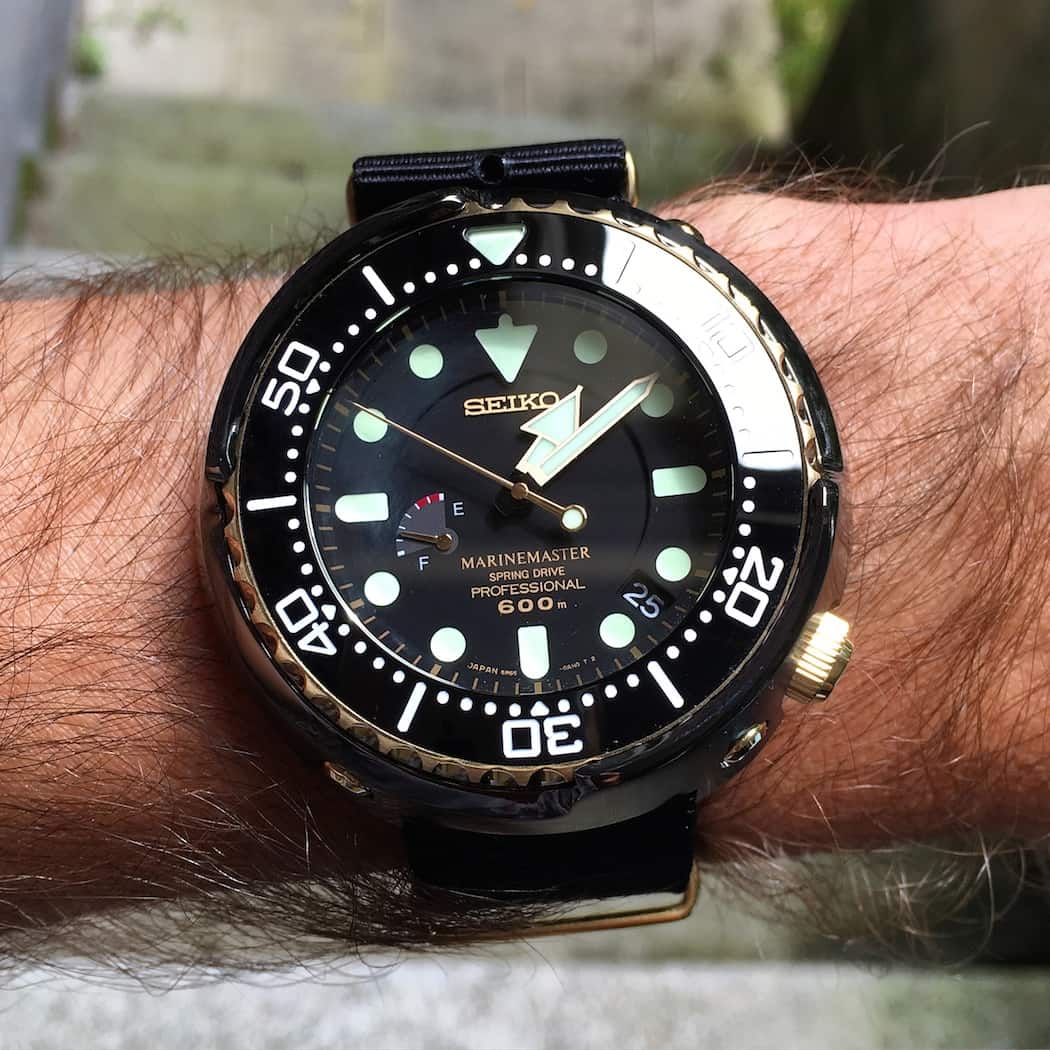
The Seiko Spring Drive Tuna on the wrist – it’s actually not that mammoth
Like all Tunas, this model wears well
When I received my Seiko Spring Drive Tuna, I had the foresight to order a 22mm NATO strap with gold hardware from Crown & Buckle. I simply knew that the supplied rubber strap was going to be way too long and too stiff for my tiny wrist and that a NATO would help me cinch the watch down appropriately. Despite its large case size, the strap did the trick and it’s actually quite reasonable from head on. I should mention that the strap provided with my Golden version is the older, stiffer style of strap previously provided with all Seiko divers at all price levels. In today’s version, the far more pliable strap is included.
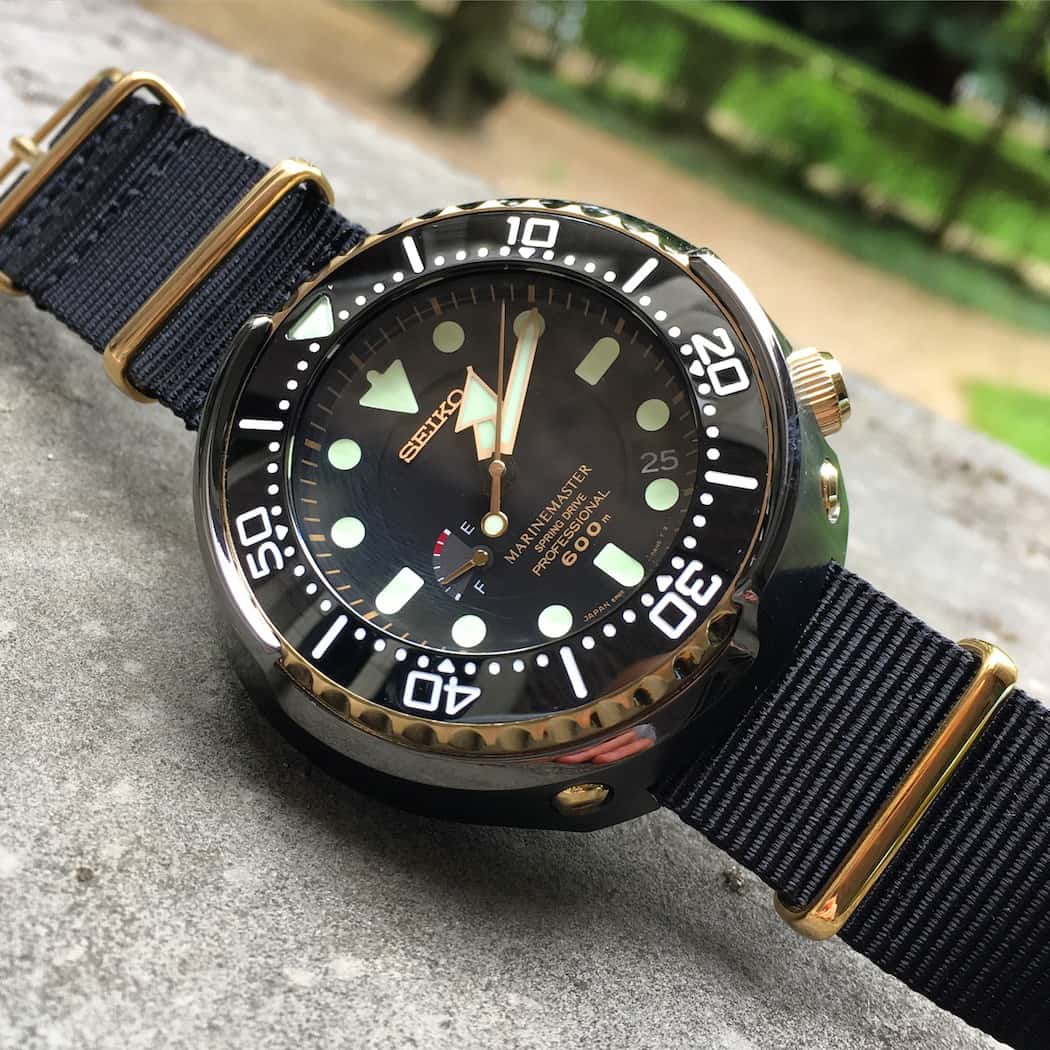
A view of the Seiko Spring Drive Tuna with its crown screwed into the case
For sure, this watch sees exactly zero time in the office and doesn’t even pretend to try and hide beneath a shirtsleeve, but it is very comfortable. It owes this comfort to its lugless design and also because the crown screws in so deeply. I called this watch zany before and it is because it’s finished so darn well, contains colors like gold more associated with dressier pieces, but yet it’s a big bruiser of a tool watch. It’s a contradiction, but I think it’s amazing.
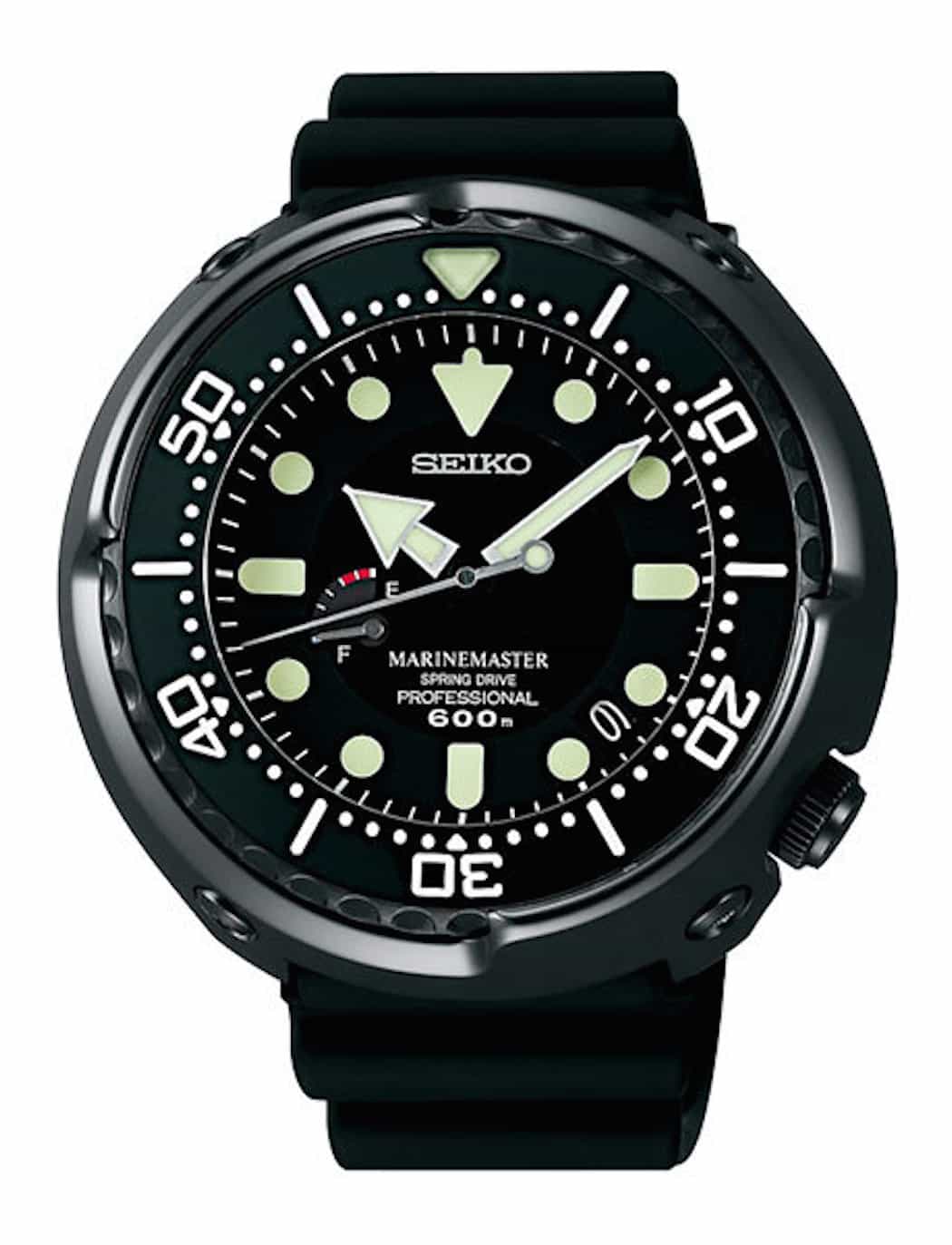
The Seiko Spring Drive Tuna SBDB009 (photo credit: Seiko)
A serial model of the Seiko Spring Drive Tuna was announced
As I mentioned, this golden version of the Seiko Spring Drive Tuna came and went in a flash in 2013, but it was clear that the brand wished to continue with a serial production model in the same vein. Roughly a year or so later, an announcement was released showing a very similar, but all black Spring Drive model, dubbed as the SBDB009. Aside from the color difference, the new strap and a price lower by roughly $500, there’s no difference versus the gold model. This watch is now the flagship of the Marinemaster Tuna line, usurping the automatic “Emperor” SBDX013.
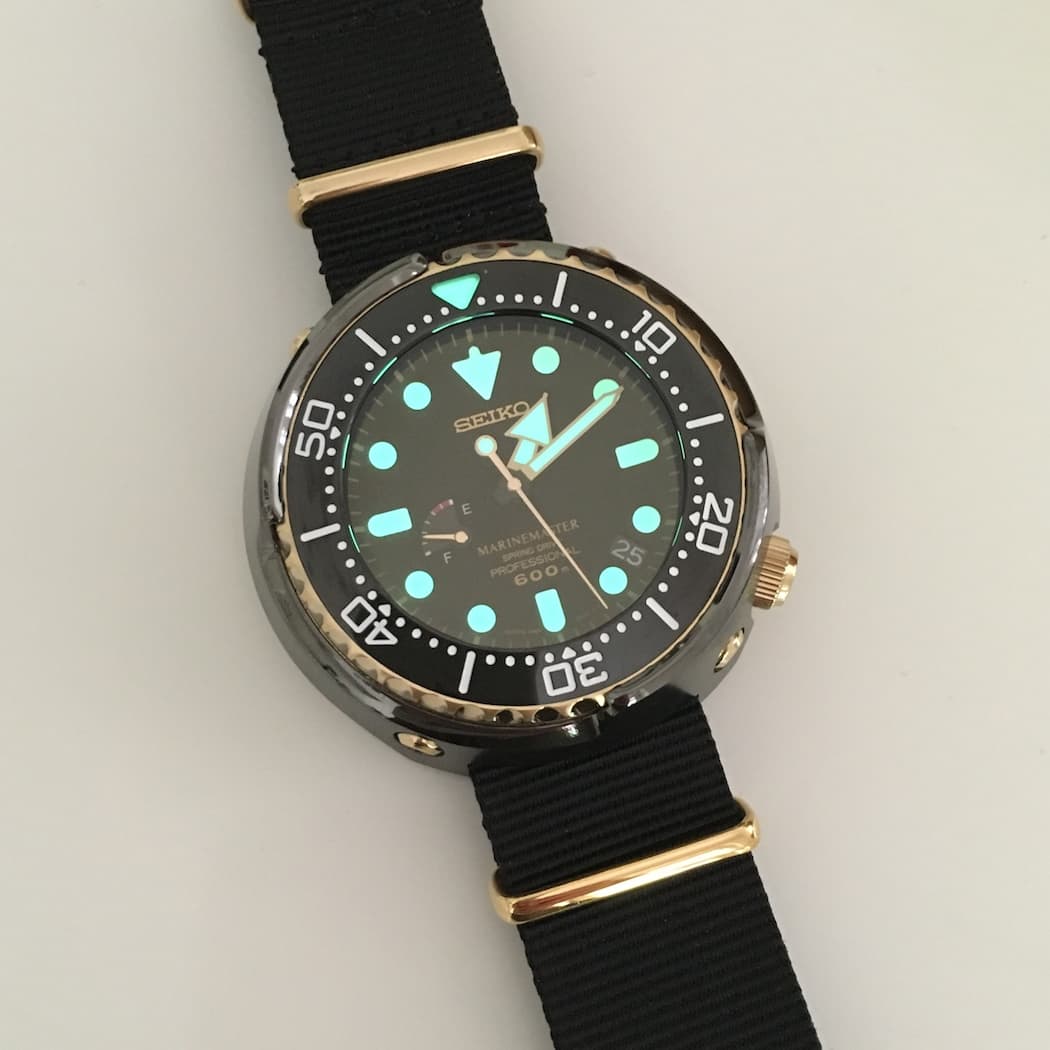
A shot of the Lumibrite on the Seiko Spring Drive Tuna
A quick look on eBay shows the current black Seiko Spring Drive Tuna for sale at roughly $3,000, which, if you haven’t held one of these watches, is a near steal for something so unique and well made. For reference, this is about $300 higher than the Emperor, so we’re not talking about a huge premium. With the all black version, you’re looking at a more tool-like watch that lacks a little bit of the “jewelry” look of the Golden version that I own and it is more comparable to the Emperor. So, it comes down to whether or not you’re interested in such an innovative style of movement in such a wild case design that will likely differ from everyone else’s on your next dive trip.
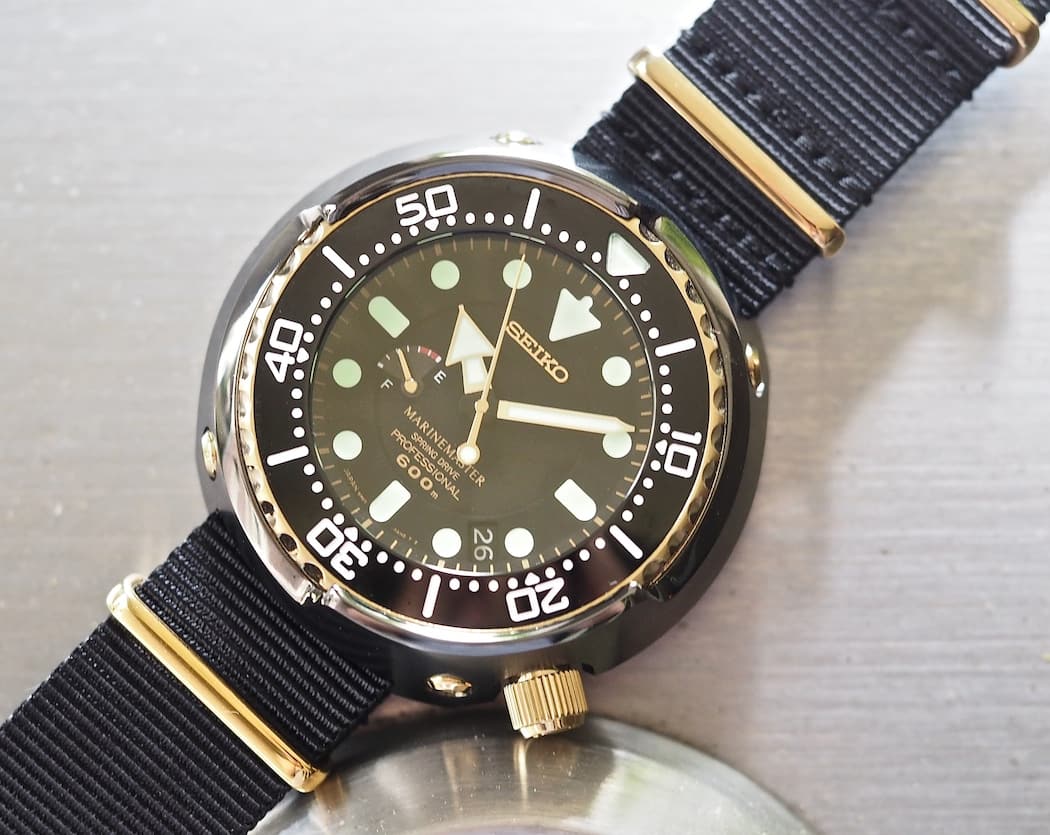
At just the hint of darkness, the Lumibrite shows itself on the dial of the Seiko Spring Drive Prospex
Does the Seiko Spring Drive Tuna have any competitors?
It’s funny; I was trying to think of the competitive set for the Seiko Spring Drive Tuna and it took me awhile. The watch is so well executed that it belongs in a class with watches like the Rolex Submariner or the Omega 300 or Planet Ocean. However, those watches are far more wearable, typically come on a bracelet and can exist in environments from the beach to the boardroom. The Tuna is decidedly more analog in its purpose. Therefore, the only watch that strikes me as a true, high-end, natural predator to the Tuna is the Omega Seamaster Ploprof. It’s also an oddly shaped watch – it fits better than one would think too – that seems more at home in the ocean than in the workplace. Of course, the Ploprof costs around $7,000, so cost is a major difference.
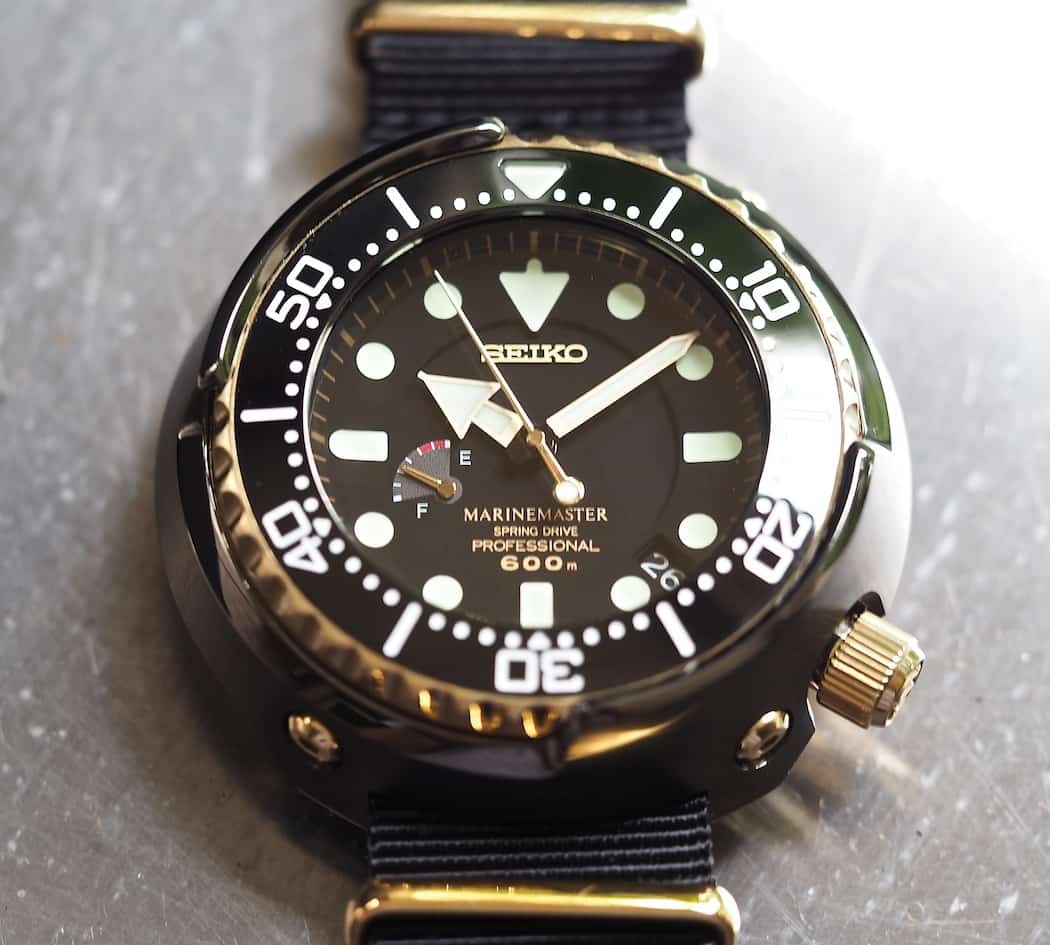
The Seiko Spring Drive Tuna in this limited edition guise is a classy, yet highly capable tool watch
I hope you enjoyed taking a look at one of the more interesting watches on the market in the Seiko Spring Drive Tuna. In some ways, think of it as something like a luxury SUV made by a sports car company. It’s not something that should work, but it somehow works well. It’s a testament to Seiko as a brand because, as stoic as they tend to be, the company continues to offer some intriguing alternatives versus its Swiss competition. On first glance, this Tuna might not be the watch for you, but I’d highly recommend trying one in person and you just might be convinced.
